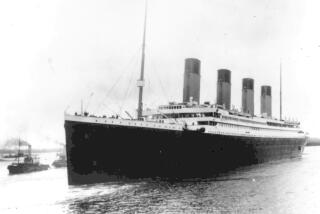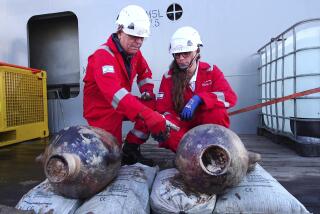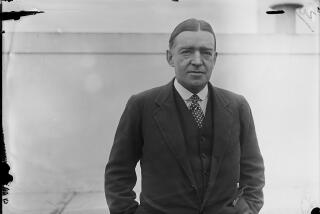Wreck of Liner Titanic Found : ‘Absolutely Certain,’ U.S.-French Team Says
PARIS — The wreck of the liner Titanic has been found by a joint U.S-French expedition off Canada in waters more than 13,000 feet deep, a French government institute and the American head of the expedition announced Monday.
The announcement from the government-run French Institute for Research and Exploitation of the Sea said that the wreck, about 370 miles south of Newfoundland, was positively identified by the French-made SAR submarine sonar system and American-made ARGO underwater cameras.
Earlier Monday, the expedition’s leader, Robert Ballard of the Massachusetts-based Woods Hole Oceanographic Institution, told the Canadian television network CTV that pieces of the Titanic were located in the early hours Sunday about 2 1/2 miles below the surface.
The Titanic, while on its maiden voyage from Southampton, England, to New York, struck an iceberg and sank April 15, 1912, with the loss of 1,513 lives among its approximately 2,200 passengers. The 882-foot-long, 45,000-ton pride of Britain’s White Star line, the Titanic was the biggest ship in the world and the most luxurious cruise liner of its era. Designed with a double bottom, it was regarded as unsinkable.
The French announcement recalled that the French and American sponsors of the expedition had agreed beforehand to make no public statement on the results of their search “unless they were absolutely certain of the facts.”
According to the Paris statement, the two institutes will organize simultaneous news conferences on the discovery in Paris and Washington on Sept. 13.
The announcement did not give the precise location of the wreck, apparently to maintain security.
Scattered on Ocean Floor
In a ship-to-shore radio interview with the Canadian network, Ballard said the wreckage was scattered over a field of debris measuring 300 by 500 yards on the ocean floor.
“We came on it early this morning--it was just ‘bang,’ there it was, right on top of it,” Ballard radioed from the U.S. Navy survey ship Knorr. “We went right through the hole.
”. . . We went smack-dab over a gorgeous boiler--I mean just straight out of all the books--and it’s just a huge area, and we decided we would pull up and get above it all.”
His team’s initial reaction, Ballard said, “was excitement, then a coming down off that to realize that we had found the ship where 1,500 people had died.”
“(For) a lot of us who had researched it for so many years, the Titanic has (become) more than a shipwreck. It’s a true disaster,” he said. “To finally put those souls to rest was a very nice feeling.”
Tight Security for Search
The 47-member expedition, including personnel from the U.S. Navy, Woods Hole, the French institute and the National Geographic Society, began the search in late June amid tight security under the code name White Star.
According to the Paris announcement, the search in the North Atlantic was begun June 28 by the French institute’s research ship Suroit, which was joined on Aug. 5 by the Knorr.
The wreck has eluded underwater treasure-hunters for decades. Among the most publicized expeditions were three financed by Jack Grimm, a Texas oilman who spent millions of dollars on searches in 1980, 1981, and 1983. After the 1981 search, Grimm claimed that videotapes showed the ship’s propeller.
Ten millionaires, among them American financier John Jacob Astor and American industrialist Benjamin Guggenheim, were on board when the ship sank. Its strong-room was filled with valuables, including diamonds and other gems now estimated to be worth $300 million.
Films, Books, an Opera
The disaster spawned a host of films, books, ballads and even an opera.
Among the books were Walter Lord’s “A Night to Remember,” Lawrence Beesley’s “The Loss of the SS Titanic” and Archibald Gracie’s “The Truth About the Titanic.”
Composer William Dieter Siebert’s opera, “The Sinking of the Titanic”--in which the opera house, in effect, becomes the ship and the audience becomes second-class passengers--has been performed in Berlin and Los Angeles.
In Hollywood, the 1958 film “A Night to Remember” was based on Lord’s book. The most recent movie was “Raise the Titanic,” in 1980, about an expedition that located the wreck and brought it to the surface.
The U.S.-French team has not suggested bringing up the ship but has proposed making the site a sea memorial.
More to Read
Sign up for Essential California
The most important California stories and recommendations in your inbox every morning.
You may occasionally receive promotional content from the Los Angeles Times.










